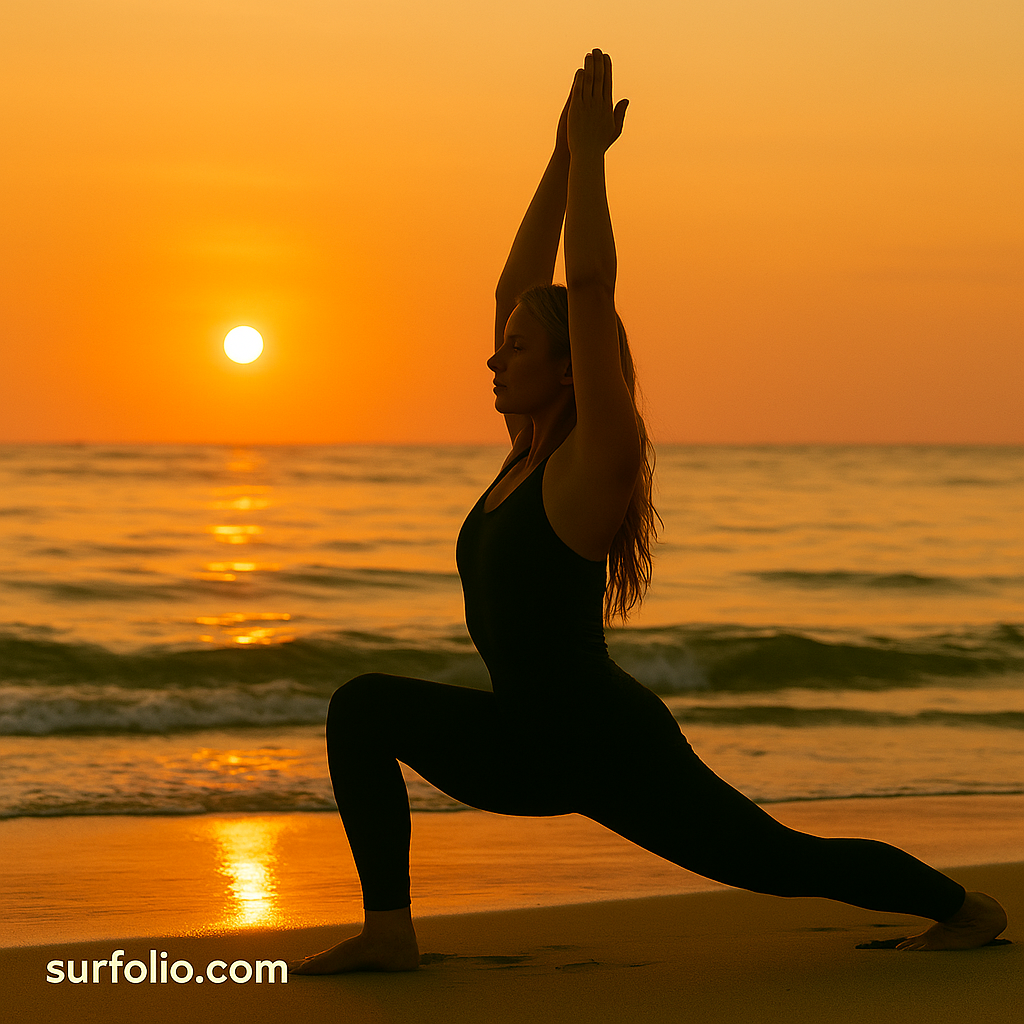
Why Yoga Belongs in Every Surfer’s Routine
Surfing isn’t just about paddling power — it’s about balance, awareness, and flow. That’s where yoga comes in.
Many of the world’s top surfers, from Kelly Slater to Carissa Moore, credit yoga for helping them stay centered both on and off the board.
By training your body to stay stable through shifting weight and motion, yoga builds the same kind of core strength, flexibility, and control you need in the lineup.
The Surf–Yoga Connection
Yoga trains three qualities that directly translate to surfing:
- Balance: Standing poses mimic the micro-adjustments of surfing.
- Flexibility: Opens your hips, shoulders, and spine for fluid movement.
- Breath control: Keeps your mind calm and your body relaxed in tough conditions.
A few minutes of yoga a day can transform how you move in the water — smoother pop-ups, steadier turns, and stronger recoveries after wipeouts.
Best Yoga Poses for Surf Balance
1. Warrior II (Virabhadrasana II)
This classic pose strengthens your legs and trains you to stay grounded while staying loose.
- Stand with your feet wide apart.
- Turn one foot out and bend your front knee.
- Stretch your arms out wide, gaze over your front hand.
Surf benefit: Builds lower-body endurance and stability for carves and cutbacks.
2. Tree Pose (Vrksasana)
A pure balance challenge — perfect for fine-tuning core and ankle control.
- Stand tall and bring one foot to your inner thigh or calf.
- Press your palms together in front of your chest.
- Engage your core and focus your gaze.
Surf benefit: Strengthens stabilizing muscles and enhances focus during takeoffs.
3. Chair Pose (Utkatasana)
This pose mimics your surf stance, firing up your thighs, glutes, and core.
- Stand with feet hip-width apart and bend your knees.
- Keep your chest lifted and arms extended.
Surf benefit: Builds endurance in the same muscles used for paddling and pop-ups.
4. Boat Pose (Navasana)
A killer core exercise that strengthens your center — the foundation of surf balance.
- Sit with your legs lifted and your back straight.
- Hold your arms forward and engage your abs.
Surf benefit: Improves stability for turns, late takeoffs, and overall board control.
5. Downward-Facing Dog (Adho Mukha Svanasana)
One of yoga’s most functional poses for surfers.
- Start on your hands and knees, then lift your hips high.
- Keep your spine long, legs straight, and heels pressing down.
Surf benefit: Stretches hamstrings and shoulders, builds paddling flexibility.
6. Eagle Pose (Garudasana)
A balance and focus test that strengthens your legs and hips.
- Wrap one leg around the other and cross your arms.
- Sink into a slight squat and find your center.
Surf benefit: Enhances coordination and control — key for surfing rail-to-rail transitions.
7. Standing Forward Fold (Uttanasana)
A grounding pose that releases tension from long sessions.
- Stand tall and fold forward from the hips.
- Let your head hang and feel your spine decompress.
Surf benefit: Improves recovery and flexibility, reducing post-surf stiffness.
Breath and Mindset: The Hidden Strengths
In yoga, your breath guides your movement — just like paddling through a tough set.
Learning to control your breathing builds mental calm and helps you recover faster between waves.
A short 10-minute practice before or after a session can reset your energy and help you surf with presence instead of panic.
Quick Surf-Yoga Routine (5 Minutes)
- Downward Dog – 5 breaths
- Warrior II – 5 breaths each side
- Tree Pose – 30 seconds each side
- Chair Pose – 5 breaths
- Boat Pose – 3 rounds of 30 seconds
- Forward Fold – finish with deep breaths
This simple flow keeps your body surf-ready — flexible, focused, and strong.
Final Thoughts
Surfing demands balance, patience, and flow — the same principles that define yoga.
With consistent practice, you’ll find not just better control on the board, but a calmer, more centered connection to the ocean itself.
Master your breath, find your center, and let balance become second nature.
